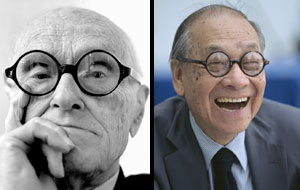Architects from Vitruvius onward have written about the building art with the same promotional goal in mind, and modern masters, led by Frank Lloyd Wright and Le Corbusier, gave new impetus to the role of architect as self-publicist in print. But not every architect is a natural writer, and the interview can be a much more efficient method for putting one’s point of view across to the public in general, and potential clients in particular.

Verbal heavyweights: Both Philip Johnson (above left) and Thom Mayne have been known to take control of an interview and not let go. I.M. Pei: “Je ne regrette rien”? (above right)
Talking Architecture made me think anew of a better example of the genre, Conversations with Architects (Praeger, 1973), by John W. Cook and Heinrich Klotz. These two books overlap by including dialogues with Johnson, as well as with Robert Venturi and Denise Scott Brown. Klotz’s long talk with Johnson has survived as a useful source for some of the architect’s more outrageous assertions, including his claim that he and his coprofessionals are whores because they work only for hire. Although he had already tossed off that cherry bomb at several lectures and conferences, it was a boon to posterity that he here committed his most notorious aperçu to print.
Another gem buried in Conversations with Architects is Charles Moore’s devastating little aside when asked if he would accept a commission for a private house from California’s then-governor Ronald Reagan, who made Moore’s life miserable when the architect served as dean at Berkeley. “Yes,” Moore told Klotz. “Then I could put lead paint in the wall.” Such flippancy aside, his remarks provide one of the most convincing records of Moore’s political awareness, an aspect reflected in his designs for some of the last high-style public housing at the end of the Great Society, schemes no longer as familiar as his playful Pop high jinks.
The biggest surprises in Talking Architecture involve regrets expressed by architects often accused of indifference to humanist values. I.M. Pei, now in his 90s, sounds uncharacteristically rueful when he says of his buildings that “I’m really happy only with a handful.… I admit I don’t have Breuer’s warmth, they’re probably too monumental for that. And that’s a defect.… I never succeeded in getting the kind of thing that Louis Kahn, for example, achieved. But I didn’t even want to.”
Although Oscar Niemeyer (who will turn 101 on December 15) has been a lifelong Communist and followed the Party line on social equality, critics have found his monumental capital city of Brasilia to be anything but hospitable to
the needs of daily habitation. Now, apparently, Niemeyer feels the same: “If I could plan Brasilia all over again,” he tells Rauterberg, “… there’d be extra apartment buildings and schools and shops. And I’d do without all the wide streets with all the cars. People would be able to walk everywhere.”
No present-day architect is more disdained for allegedly sidestepping social issues than Rem Koolhaas, who has maintained that urban planners must take the world as they find it and not think they can reform it. But in Talking Architecture he sounds a very different note from such laissez-faire detachment, although whether or not his protestations are sincere only time will tell.
“These days everything is now decided by the last ideology we still have, the ideology of the market,” says Koolhaas, who has been condemned for playing to those very market forces. “Fifteen years ago it was taken for granted that architects worked for public clients, i.e., their eye was on the public benefit. That social dimension of architecture has meantime almost disappeared, as the state has retreated.… Think of the fantastic new [housing] estates that J.J.P. Oud managed to build. He designed not just a few facades but also laid down how many schools, churches and shops were also needed in one area.”
Reading good interviews offers a mildly illicit thrill akin to that of eavesdropping on a spicy conversation, just as reading books of famous figures’ correspondence can give a frisson like opening other people’s mail. As long as architects continue to speak, we will continue to listen, because the constructs they first sketch with words are the earliest evidence of the structures they bring to reality after all is said and done.



Post a comment to this article
Report Abusive Comment